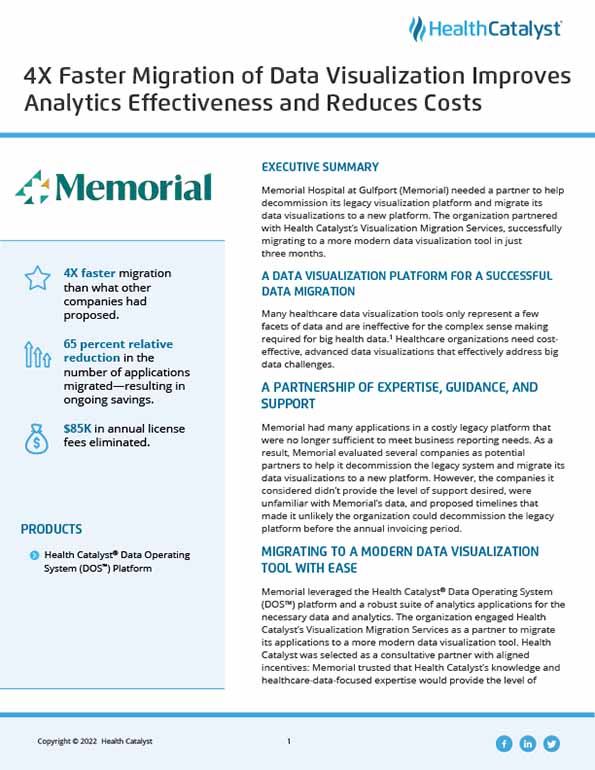Memorial Hospital at Gulfport (Memorial) needed a partner to help decommission its legacy visualization platform and migrate its data visualizations to a new platform. The organization partnered with Health Catalyst’s Visualization Migration Services, successfully migrating to a more modern data visualization tool in just three months.
Many healthcare data visualization tools only represent a few facets of data and are ineffective for the complex sensemaking required for big health data.1 Healthcare organizations need cost-effective, advanced data visualizations that effectively address big data challenges.
Memorial had many applications in a costly legacy platform that were no longer sufficient to meet business reporting needs. As a result, Memorial evaluated several companies as potential partners to help it decommission the legacy system and migrate its data visualizations to a new platform. However, the companies it considered didn’t provide the level of support desired, were unfamiliar with Memorial’s data, and proposed timelines that made it unlikely the organization could decommission the legacy platform before the annual invoicing period.
Memorial leveraged the Health Catalyst® Data Operating System (DOS™) platform and a robust suite of analytics applications for the necessary data and analytics. The organization engaged Health Catalyst’s Visualization Migration Services as a partner to migrate its applications to a more modern data visualization tool. Health Catalyst was selected as a consultative partner with aligned incentives: Memorial trusted that Health Catalyst’s knowledge and healthcare-data-focused expertise would provide the level of support desired—successfully assisting the organization in shortening the analytics life cycle and efficiently migrating the applications.
Health Catalyst and Memorial established measurable goals and performed an enterprise-wide strategic assessment to identify the legacy applications that needed to be migrated and find opportunities to retire and consolidate applications. Health Catalyst also developed and provided a road map and processes for efficient and strategic migration.
Health Catalyst converted applications and dashboards from the legacy platform to a modern tool using best practices and standardized processes, including project plans, a standardized BI template, developer playbooks, best practice guides, design standards, user-acceptance testing, developer training, and end-user training. Memorial and Health Catalyst collaborated to ensure on-time delivery of critical applications and features in the new data visualization tool. The migration provided Memorial with an opportunity to validate the data in each application and assess data utilization. Migration also provided an opportunity to perform data cleanup activities.
In just three months, Health Catalyst’s Visualization Migration Services supported Memorial’s migration to a modern tool with features that the legacy system couldn’t offer, including geospatial analysis, augmented intelligence, and push notifications. Results include:
Health Catalyst managed and performed the migration, enabling the Memorial team to focus on other organizational IT priorities, minimizing disruptions, and ensuring the organization retired the applications and dashboards from the legacy tool before the annual invoicing period. In addition to improved data visualizations and cost savings, data cleanup and migration activities have resulted in improved analytics platform system performance.
"I’ve been a part of many upgrades with other systems and vendors. The Health Catalyst Visualization Migration Services team is at the top of my list for ease-of-use and effectiveness."
- Darlene Howard, Data Scientist, Memorial Hospital at Gulfport
Memorial plans to make new data sources available in its new data visualization tool, expanding the availability of meaningful, actionable data and further increasing the value of its analytics investment.


